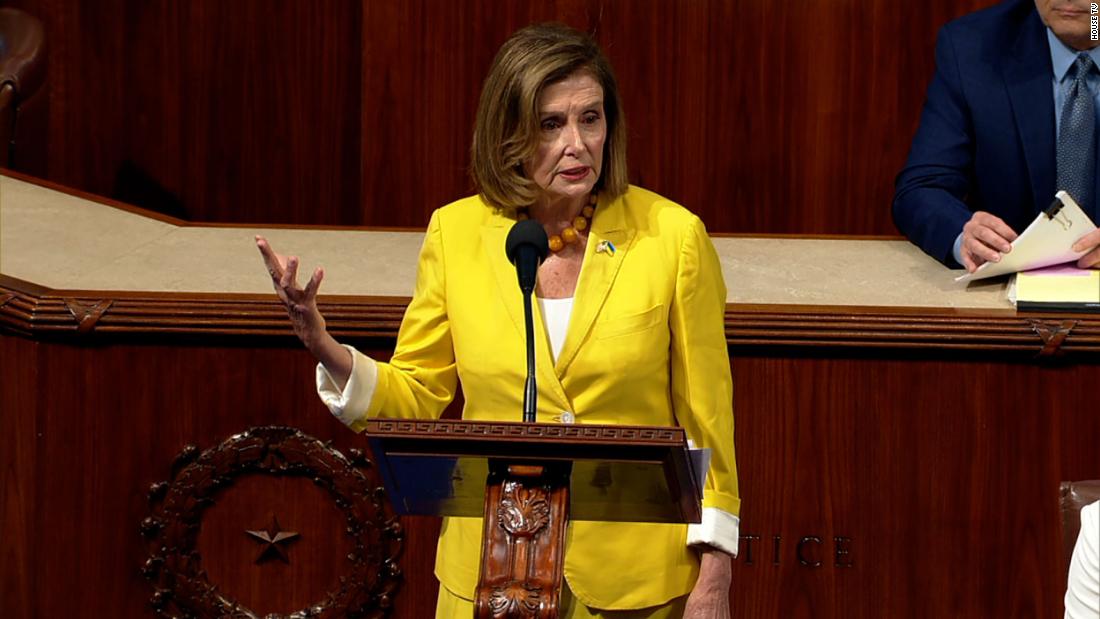[ad_1]
The final vote was 220-207, along party lines. Four Republicans did not vote.
Now that the Democratic-controlled House has approved the bill, it will next go to Biden to be signed into law.
Final passage of the bill marks a milestone for Democrats and gives the party a chance to achieve long-sought policy objectives ahead of the upcoming midterm elections. It comes at a critical time as Democrats are fighting to retain control of narrow majorities in Congress.
It would raise over $700 billion in government revenue over 10 years and spend over $430 billion to reduce carbon emissions and extend subsidies for health insurance under the Affordable Care Act and use the rest of the new revenue to reduce the deficit.
House acts after Senate Democrats passed the bill
In the Senate, the bill passed on a final, party-line vote of 51-50, with Vice President Kamala Harris breaking the tie.
Senate Democrats, who control only a narrow 50-seat majority, ultimately stayed unified to pass the legislation. And they used a special, filibuster-proof process known as reconciliation to approve the measure without Republican votes.
Approval of the bill in the chamber marked a major milestone for Senate Democrats, who had long hoped to pass a signature legislative package, but had struggled for months to reach a deal that had the full support of their caucus.
Passage in the Senate came after a lengthy stretch of amendment votes known as a “vote-a-rama” that lasted nearly 16 hours from late Saturday night until Sunday afternoon.
In the end, Republicans lined up to oppose the bill. Senate Minority Leader Mitch McConnell said in a statement that the bill included “giant job-killing tax hikes” and amounted to “a war on American fossil fuel.” The Kentucky Republican said Democrats “do not care about middle-class families’ priorities.”
How the bill addresses the climate crisis
The nearly $370 billion clean energy and climate package is the largest climate investment in US history, and the biggest victory for the environmental movement since the landmark Clean Air Act.
Analysis from Schumer’s office — as well as multiple independent analyses — suggests the measure would reduce US carbon emissions by up to 40% by 2030. Strong climate regulations from the Biden administration and action from states would be needed to get to Biden’s goal of cutting emissions 50% by 2030.
The bill also contains many tax incentives meant to bring down the cost of electricity with more renewables, and spur more American consumers to switch to electricity to power their homes and vehicles.
Key health care and tax policy in the bill
The bill would empower Medicare to negotiate prices of certain costly medications administered in doctors’ offices or purchased at the pharmacy. The Health and Human Services secretary would negotiate the prices of 10 drugs in 2026, and another 15 drugs in 2027 and again in 2028. The number would rise to 20 drugs a year for 2029 and beyond.
The controversial provision is far more limited than the one House Democratic leaders have backed in the past. But it would open the door to fulfilling a longstanding party goal of allowing Medicare to use its heft to lower drug costs.
Democrats are also planning to extend the enhanced federal premium subsidies for Obamacare coverage through 2025, a year later than lawmakers recently discussed. That way, they wouldn’t expire just after the 2024 presidential election.
To boost revenue, the bill would impose a 15% minimum tax on the income large corporations report to shareholders, known as book income, as opposed to the Internal Revenue Service. The measure, which would raise $258 billion over a decade, would apply to companies with profits over $1 billion.
Concerned about how this provision would affect certain businesses, particularly manufacturers, Sinema has suggested that she won changes to the Democrats’ plan to pare back how companies can deduct depreciated assets from their taxes. The details remain unclear.
However, Sinema nixed her party’s effort to tighten the carried interest loophole, which allows investment managers to treat much of their compensation as capital gains and pay a 20% long-term capital gains tax rate instead of income tax rates of up to 37%.
The provision would have lengthened the amount of time investment managers’ profit interest must be held from three years to five years to take advantage of the lower tax rate. Addressing this loophole, which would have raised $14 billion over a decade, had been a longtime goal of congressional Democrats.
In its place, a 1% excise tax on companies’ stock buybacks was added, raising another $74 billion, according to a Democratic aide.
CNN’s Alex Rogers, Ella Nilsen, Tami Luhby, Katie Lobosco and Matt Egan contributed to this report.
[ad_2]
Source link


